
社區面面觀
A Survey of Yilan Community
本縣從1995年頃全縣之力投入社區總體營造的志業,將社區總體營造的過程視為終生學習的過程,更將社區意識的凝聚、地方產業的轉型、在地文化的維護、自然生態與公共環境等納入縣內社區總體營造的主要工作範疇。在這20幾年營造過程中,每個社區都是以營造生活、生態及生產三生共構的社區為目標。在眾多營造社區中,謹以大二結社區從千人移廟保存二結王公舊廟、搶救二結穀倉指定為歷史建物守護社區珍貴生活文化資產;白米木屐村從守護社區環境開始營造之路,木屐產業則活絡社區經濟促進在地就業,並戮力推動白米生態村;內城社區長期守護好山好水的社區生態,以鐵牛力阿卡車隊經營社區深度體驗遊程創造長者在地就業樂活,假日小農市集做為農作物展售平台,以里山內城為營造志業等三個社區營造過程與成果代表分享。
大二結文化保存大事記
1991年
二結王公廟計畫重建
1993年
二結王公廟新廟動土
1994年
社區提出保存舊廟的主張
1995年
大二結文教促進會成立
1995年
促進會訂定政治排除條款
1996年
二結圳生活步道完工
1997年
舉辦「千人移廟」活動
1998年
二結穀倉指定縣定古蹟
2010年
開辦大二結王公藝術研究所
2011年
二結穀倉稻農文化觀開館營運
2011年
成立大二結文化基金會
2012年
辦理「祈冬」傳統藝術節迄今
2013年
大二結紙文化館開館
2015年
基金會榮獲文化部古蹟歷史建築管理維護優良單位獎
2017年
基金會榮獲第4屆國家文化資產保存獎
政治排除條款
建立社區組織主體性的第一步,堅持排除政治不當介入的可能性。
推動社區公共事務,需要以客觀與無私的態度展開,若利用社區組織來累積個人或派系政治資源,將可能嚴重影響居民的參與、信任及社區發展。
大二結文化基金會長期經營社區,深知地方派系介入社區事務的負面影響,為了保持最理想的社區公益組織運作,因此特地於組織章程中明定政治排除條款,建立一套避免派系與政治的不當介入機制,以免影響事務推動的客觀性。
包含「凡是經由人民直接選舉產生之各級地方民意代表及公職人員,不得擔任本會的理、監事,總幹事等職」,以及「本會會員(含名譽理、監事、顧問)不得利用宜蘭縣大二結文教促進會的名銜參與或贊助政黨及公職人員競選活動」等規定。
二結圳生活步道
二結居民對社區環境改善的積極主張及參與,讓美麗生活步道成真。
二百多年來流貫大二結的生命之河二結圳,在1996年初,因發現水利單位陸續對境內灌溉水圳進行全面『整治』改為U型水泥溝壁設施,怪手已轟隆隆,一鏟一鏟地將水圳兩側卵石砌成的護堤挖掉了一大半,二結圳的卵石記憶及多樣生態,隨著一車車的卡車運走而破滅。
基金會成員認為,社區生活環境的維護,必須靠居民自發性及積極的行動來完成,在台大城鄉基金會宜蘭工作室的協助下,與公路局、水利會、鄉公所展開長達三年的溝通與討論,並處理繁雜的行政程序,同時也要處理居民不同的聲音,所幸遇上熱心的公務員和規劃單位,在他們的協助下,讓二結人的美夢得以成真。
開創地方保存奇蹟的千人移廟
保存的不只是一座舊廟,而是民眾的共同生活記憶。
1993年大二結社區居民們正想為心中的守護神「二結王公廟」換新家,有人主張要拆除,有人認為要妥善保留,不管意見如何,二結人不想讓「王公廟」與其他廟宇一樣被輕率地拆除,而選擇用千人移廟的合力方式,保存舊廟成為二結生活文化館。
因為,剝落的彩繪、泛黑的雕梁、廟埕的老樹、過火的空地以及上香祈求平安的生活點滴,是二結人共同的記憶。在大二結文化基金會的策動下,居民從單純對舊廟的情感到對文化資產保存的觀念,從社區歷史記憶的保存到社區公共空間的營造,重新連結人跟人之間的關係,也重新建構人與土地的情感。
二結穀倉稻農文化館
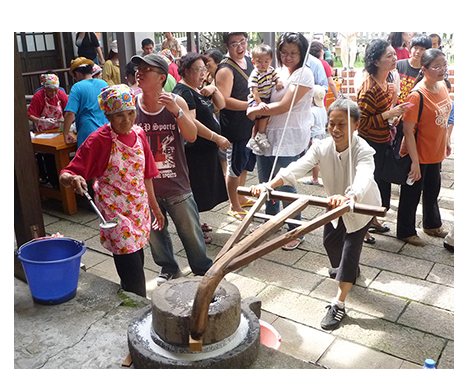 老穀倉新生命
老穀倉新生命
文化資產是一種生活脈絡而非只是形式,「保存」是記憶/傳承過去,「活化」則是延續/創造未來。1998年初二結穀倉面臨拆除命運,隨即展開一系列搶救行動,一路資料收集、低調進行後,即向縣政府訴請獲得古蹟指定,隨後在基金會爭取下,歷經十四年的保存、修復,「活化」即將是二結穀倉邁入新生命的重要課題,二結穀倉從去地方性、單調、商品化、模式化生產與過度發展的負向作用,踏實的回到日常生活,從歷史、產業、人物、祭儀、景觀、生態、故事中去探尋前人的足跡,去重新發現、珍視身邊的所有,並且付諸行動來連結我們的過去與未來,使得世世代代都能認同土地,安身立命。
大二結紙文化館
這裡是保存與延續大二結紙文化與生命的地方。
曾經是全台製紙工業重鎮的大二結社區,見證了百年紙業的興盛與式微,對「造紙」有著無可言喻的濃厚情感。2001年紙廠關門,大二結社區居民仍念念不忘紙廠的輝煌歲月。在紙廠退休員工及紙藝術家的指導之下,大二結文化基金會租下五結農會11號倉庫,成立大二結紙文化館。基金會除了利用紙廠所提供的工業紙漿、再生環保紙漿及植物紙漿等各式原料,從大二結的人文、建築、環境、生活故事取材,製成珍貴特殊的「手工紙」,讓每張紙都有自己的內涵與故事、每張紙都是唯一的作品外。也將中興紙廠結束生產後搶救回來的文物及文獻,透過重新整理規劃為紙廠辦公區、生產區、宿舍及員工福利設施區等,重新以展示與手工紙藝創作的方式,傳遞這份情感,來延續大二結紙文化與生命。
大二結王公藝術研究所
一個由民間自主策劃,融合於常民生活的傳習計畫
對社區的居民們來說,家人、鄰居、朋友,甚至遠道而來的民眾都是學習的伙伴;而廟埕、穀倉這些與生活結合的社區公共空間就是學習的場域,這是大二結王公藝術研究所的核心理念。
有別於學術的殿堂或菁英式的教育,大二結王公藝術研究所,希望創造出以社區居民為主體的學習環境,讓人人都能在生活中都能夠體會藝術的樂趣,進而達到文化保存、延續的目標。同時也營造一個藝術交流的平台,讓宜蘭的藝師在這裡合作、交流。結合四時的節慶,透過集體參與的機會,保存傳統節慶及農村文化價值,並且提升常民的藝術生活。

祈冬
一個凝聚地方情感的慶典
傳統藝陣多由地方子地扮演與參與,但是因社會結構的改變,出現了職業性的陣頭。大二結文化基金會為了重新凝聚地方意識,希望藉由新慶典的產生,讓社區各團體、各級學校學生、廟宇等藉由負責「祈冬」活動各陣頭並擔任角色。
「立冬」為冬天之始。是需要進補的日子。我們在每年的這一天舉辦「祈冬」節慶,除了邀請大家一同吃燒酒雞、米糕補身外,也邀請大家一起參與及一起來欣賞「大二結王公藝術研究所」的藝陣表演,來療癒心靈。我們希望藉由「祈冬」節慶的辦理,找回與紮根傳統藝術文化外,更藉由慶典的籌劃,重新凝聚地方意識與情感。
A Survey of Yilan Community
Since 1995 Yilan has invested the full might of the entire county in achieving the goal of comprehensive community development. We see the process of development as one of lifelong learning. Development of a community identity, transformation of local industry, and the protection of local culture, natural ecology, and the shared environment are key goals of our efforts. Over these more than two decades of progress, the goal of every community is to be a place where residents, the natural environment, and industry can all thrive. Daerjie Community has been at the forefront of protecting the community’s precious cultural assets. Efforts have ranged from enlisting the help of thousands to move and preserve the old Erjie Wanggong Temple to saving the Erjie Rice Barn and getting it designated as a historic structure. Since Baimi Clogs Village began its development journey by protecting the environment, the wood clogs industry has revitalized the economy and created local jobs, while the community continues to promote the Baimi Ecological Village. Neicheng Community has long earned its reputation for beautiful mountains and clean water by protecting those assets. The local A-ka “Iron Cow” fleet gives visitors an in-depth community tour and provides jobs for older residents, while the weekend farmers market gives local farmers a place to sell their wares. We will give you an in depth look at the community building process and achievements in these three representative communities.
Daerjie Cultural Preservation Milestones
1991
Erjie Wanggong Temple reconstruction proposed
1993
Ground broken on the new Erjie Wanggong Temple
1994
The community proposed to preserve the old temple
1995
Daerjie Cultural Promotion Association (DCPA) established
1995
DCPA formulated rules against political activity
1996
Erjie Canal Walking Path completed
1997
Thousands participated in moving the old temple
1998
Erjie Rice Barn designated a county-level historic site
2010
Daerjie Wanggong Art Institute established
2011
Erjie Barn Rice Farm Culture House opened
2011
Daerjie Cultural Foundation established
2012
Annual Winter Festival Traditional Arts Celebration first held
2013
Daerjie Paper Museum opened
2015
Daerjie Cultural Foundation received the Award of Excellence in the Ministry of Culture's Historical Building Management and Maintenance Evaluation
2017
Daerjie Cultural Foundation received the Conservation Contribution Prize at the Fourth National Cultural Heritage Conservation Awards
Rules against political activity
The first step in establishing the independence of community organizations: eliminating inappropriate political interference.
Promoting public affairs within the community must originate from an objective and unselfish attitude. If community organizations are used to accumulate political power for oneself or one’s political faction, this will severely diminish resident participation and trust, thereby impeding community development.
The Daerjie Cultural Promotion Foundation has long worked to empower the community and deeply understands the negative impacts of local political factions intervening in community affairs. To ensure community welfare organizations function properly, the foundation specifically included anti-political clauses in its charter. This establishes a set of mechanisms to prevent inappropriate intervention by factions and politics and promote of objectivity.
These clauses include, “Any local elected representative or official at any level chosen by a direct election by the people may not serve as a director, supervisor, or director-general of the Foundation” and “Members of the Foundation (including honorary directors and supervisors, and consultants) may not utilize their title within the Yilan Daerjie Cultural Foundation to participate in or sponsor a political party or candidate during a political campaign”.
Erjie Canal Walking Path
Resident involvement made environmental improvements a reality
The Erjie Canal flowed through Daerjie for more than 200 years. In early 1996, it was discovered that water resources agencies were implementing a comprehensive irrigation overhaul and replacing the canal with a U-shaped concrete channel. The excavators rumbled into town and began removing shovelfuls of pebbles that formed the original banks of the canal. Erjie Canal's pebbles and diverse ecosystem were destroyed and taken away one dump truck at a time.
Foundation members believe successful community environmental protection efforts must rely on residents' active participation. With the assistance of the National Taiwan University Building & Planning Foundation Yilan Branch, three years of communication and discussion began with the Directorate General of Highways, Department of Irrigation and Engineering, and Township Office, while a series of complex administrative procedures were also implemented. At the same time, the various opinions of residents had to be considered. Fortunately, under the guidance of enthusiastic public servants and planning agencies , the dreams of Erjie residents came true.
A miracle of historical preservation
A temple was saved, but also residents' shared memories.
In 1993, Daerjie Community residents wanted to give Erjie Wanggong Temple a new home. Some proposed tearing down the old temple, while others wanted to preserve it. No matter their opinion, the people of Erjie did not want their Wanggong Temple to be demolished in a cavalier manner like some in the past. In the end, they decided to use the collective power of thousands of people to move the old temple, which would be preserved as the Erjie Cultural Museum.
The peeling paint, blackened carved beams, old trees, firewalkers in the plaza, and all of the incense burned and prayers said within the temple had a special place in the hearts of Erjie residents. With encouragement from the Daerjie Cultural Foundation, residents transformed this love of the old temple into a desire to safeguard their cultural resources. Preserving the community's historical memory evolved into construction of new public spaces. This process helped reconnect people with one another and rebuild the emotional connection between residents and the land.
Erjie Barn Rice Farm Culture House
 A new life for an old barn
A new life for an old barn
Cultural heritage is not just an abstract concept, it is part of our everyday lives. Preserving our cultural heritage is to remember and pass on the past, while revitalizing cultural heritage is to use these resources to build a future. In early 1998, the Erjie Rice Barn was facing demolition. Immediately, a series of rescue operations were initiated. The community collected information, then applied with the county government for heritage site protections. With Foundation support, the Erjie Rice Barn got a new lease on life after 14 years of preservation, renovation, and revitalization. From a drab, provincial symbol of industrialization and overdevelopment, the barn made a return to people's everyday lives. From history, industry, people, rituals, landscape, ecology, and stories, we can discover traces of our ancestors and learn to cherish what we see around us. By protecting our heritage, we link the past with our future and future generations.
Daerjie Paper Museum
A place to preserve and pass on Daerjie's paper culture
Daerjie Community, once at the heart of papermaking Taiwan, witnessed the rise and decline of the century-old industry. There are still indescribably strong emotions towards paper making within the community. The paper mill closed in 2001, but many Daerjie residents remember its glory days. With the guidance of retired mill workers and paper artisans, the Daerjie Cultural Foundation leased the Wujie Township Farmers Association's Warehouse No. 11 and established the Daerjie Paper Museum. Utilizing raw materials such as industrial pulp, recycled pulp, and plant fiber pulp provided by the paper mill, the Foundation produced precious handmade paper featuring cultural, architectural, environmental, and lifestyle motifs from Daerjie. Every sheet of paper has its own story and significance, and each is one of a kind. Objects and documents were saved after the Chung Hsing Paper Mill shut down. The museum was divided into the office, production, dormitory, and employee store to display these important remnants from the factory along with a handmade paper workshop. With the museum, this important part of Daerjie history and residents' lives can live on.
Daerjie Wanggong Art Institute
Traditional art for the people by the people
In the community, family, neighbors, friends, and even far away visitors can all be our partners in learning. Public spaces part of residents' daily lives, like temples and the rice barn, are all learning spaces. This is the core concept of the Daerjie Wanggong Art Institute.
Far from an ivory tower, Daerjie Wanggong Art Institute instead hopes to create an academic environment with community residents at its center. Everyone can experience the joy of art in their everyday lives and achieve the goal of cultural preservation and promotion. At the same time, the Institute is a platform where artists can collaborate and interact with one another. Throughout each year's festive holiday celebrations, the opportunity to participate together will preserve local traditions and farming village culture, while bringing art into the lives of regular people.

Winter Festival
A celebration that unites a community
Participants in traditional folk performances at religious celebrations used to come from within the community. As society has changed, professional troupes have emerged to take over this role. Daerjie Cultural Foundation hopes to rebuild a sense of local consciousness through the creation of a new annual celebration. Participants from community groups, local schools, and temples are all responsible for planning and performing in the Winter Festival.
Lidong is the date on the lunar calendar marking the start of winter. It is a day to fortify oneself for the upcoming season. On this day each year, the community holds the Winter Festival. Not only do we invite everyone to eat warming dishes like wine-braised chicken and glutinous rice, we also encourage them to participate in and enjoy the Daerjie Wanggong Art Institute's traditional folk performance, a tonic for the soul. We hope that by holding the Winter Festival, traditional art forms can reemerge and take root in the community. Through planning the celebration, the community can also build local awareness and pride.
白米木屐村
從全國落塵量最高到世界知名的社區生態博物館
位於蘇澳白米溪流域的白米社區,三面環山,溪底佈滿白石,高處眺望猶如米甕傾倒流出白米,因此特殊地形而自古有白米甕之稱。在白米社區流傳俚語『白米甕,出柴屐,偷剉柴,山林抓』印證此地曾有的木屐歷史,因周邊山林盛產木屐原料「江某樹」而讓此地成為木屐產地,日本時代更有木屐巢之盛譽。隨著時代變遷,塑膠鞋盛行,木屐產業沒落消失,只留在中老年人的腦海中。 今日社區以永春里為主要範圍,此地也是清朝漢人於蘇澳初期移墾的第一個聚落『永春城』,惟舊城年代久遠空間範圍已不可考,今日除了地形依舊,便是石礦產業帶來蓬勃工業發展,也帶來白米社區漫天灰塵空氣汙染的危機。
今日社區以永春里為主要範圍,此地也是清朝漢人於蘇澳初期移墾的第一個聚落『永春城』,惟舊城年代久遠空間範圍已不可考,今日除了地形依舊,便是石礦產業帶來蓬勃工業發展,也帶來白米社區漫天灰塵空氣汙染的危機。
白米社區自日治時期開始,有十多家生產『石米仔』的工廠,為社區居民帶來不少工作機會,但是工廠日以繼夜的運作溢散污染物,以及運送礦石的大卡車,帶來的噪音跟揚塵,讓白米人無法避免無孔不入的灰塵,生活品質低落,能離開的便搬走,人口嚴重外流。
1994年適逢中央推出社區總體營造政策,逐步轉向社區內部組織培力,1995年為全縣率先正式於臺灣宜蘭地方法院登記為社團法人,完備社區組織,1999年籌組社區合作社推動木屐產業,陸續改造周邊閒置空間,廢棄托兒所,2015年成功爭取蘇花改白米景觀橋、白米段平面便道與腳踏車道,2017年活化民宅成為白米木益客棧,2018年成功恢復消失的水稻種植地景,讓白米社區真的長出白米。這一連串近三十年的白米社造過程艱辛,白米社區的故事,具體展現在社區環境保護、文化產業創生與社區文化重建等等歷程,追尋白米社區的美好家園是一個重要的社造基礎,也是白米社區居民持續努力不懈且令人感動的地方。
品牌故事
●玫瑰花木屐的故事
描述一位邋遢的人,偶然獲得一朵玫瑰花後,為了匹配美麗花朵而展開一系列改變環境和其自身,最後邋遢人與環境都因為這朵玫瑰花,帶來煥然一新的新世界。
對白米社區而言,把「玫瑰花」畫在木屐上,是要提醒白米社區從過去全國落塵量最高的空汙環境,到社區居民有意識的整理環境,進而發掘在地的人文歷史,最後選擇「木屐」作為社區產業的整個過程。
「玫瑰木屐」是白米社區的精神象徵,提醒大家莫忘「做社區」的初衷!
●仙履奇緣
木屐是白米社區的標誌,從木屐出發,1997年,第一屆全國社區總體營造博覽會在宜蘭運動公園舉行。白米社區帶著木屐參加,給自己的攤位取了「仙履奇緣」這個意象萬千的名字,沒想到各界反應熱絡,獲得巨大回響,木屐也因此成為白米社區營造的轉捩點!  ●十全十美木屐舞
●十全十美木屐舞
2001年白米社區藉由勞委會永續就業工程計畫,許多社區女性投入社區工作,社區發展協會也安排許多課程,後來健康操便發展出木屐舞碼「圓滿」。雖然不是專業的演出,卻鼓勵社區婦女積極參與公共事務,也讓他們可以用舞蹈來呈現自我的生命故事。
「圓滿」主要述說婦女穿著ㄎ一ㄎㄚ~ㄎ一ㄎㄚ~作響的木屐,穿梭在社區的巷弄裡,愉快地分工合作,當想起遠在他鄉的兒孫,會有人來安慰難過的心情,大夥就是如此相互關照就像是一群好姊妹,分享著彼此的喜怒哀樂。
●閒置空間再利用的典範「白米木屐館」:
今日白米木屐館原本是台灣肥料公司廢棄六間並排舊員工宿舍,社區居民在1997年美化社區環境空間,把這個廢棄已久的建築空間徹底清潔,並跟台灣肥料公司洽商租借使用。經過社區居民合力籌組白米合作社,合資將該廢棄空間買下,逐步改善與整建成今日的木屐館。
社區居民為了推動木屐產業,遠赴日本跟荷蘭參觀木屐產業,逐步改善社區廢棄空間,包含整治周邊廢棄倉庫、木屐發源地公園、廢棄托兒所等等,展開一連串的社區空間再造運動,是台灣社區自主推動閒置空間再利用的重要典範。
故事館年表
1972年
(清道光7年)永春城興建永春晉安宮(1872年遷移蘇澳市區現址)。
1874年
(清同治 13 年) 提督羅大春開鑿蘇花古道。
1935年
(昭和 10 年) 水患整治,社區居民自動發起建造河堤工程美舉。
1942年
日資臺灣化成工業株式會社蘇澳工場竣工,生產セメント(水泥) 。
1970年
代中油公司於白米社區設立油庫,讓生態豐富的蛙子湖消失,住民遷離
1983年
全臺落塵量第一名,宜蘭縣政府啟動汙染取締的青天與碧泉計畫
1992年
臺泥公司與宜蘭縣政府簽署「環保協議書」,為國內第一件公害契 約模式。
1993年
居民成立白米社區發展協會(1994年完成登記)。
1995年
第一筆臺泥環保回饋金,完成白米社區整體規劃案。
1997年
3月全國社區總體營造博覽會,以仙履奇緣主題重新打響木屐文 化。
1998年
11月成立保證責任宜蘭縣蘇澳鎮白米社區合作社。
2001年
5月宜蘭縣博物館家族協會於白米社區正式成立。
2004年
7月自主完成永春路生活道路景觀改善工程細部規劃。
2004年
9月為木屐找個家,進行白米木屐館的增建工程。
2006年
6月雪隧通車。
2006年
7月木屐館試營運。
2007年
3月白米木屐館正式啟用,為白米社區木屐產業奠定新的里程碑。
2010年
10月蘇澳水患,11月環保署有條件通過蘇花改環境影響評估。
2011年
8月木屐老師傅陳信雄仙逝,獲宜蘭縣政府頒發褒揚狀。
2014年
10月宜蘭縣政府通過白米社區農村再生計畫。
2017年
新增白米木益客棧,將木藝與公益結合。
2017年、2018年
連續舉辦舉辦白米夏令營。
2018年2月
蘇花改第一階段通車,白米景觀橋及蘇花改地面便道與腳踏車道,改善永春路遠離卡車。
2018年4月
白米社區讓消失四十年的稻子在白米景觀橋下重新復耕(同年8月採收)
故事持續發生中...... 。
Baimi Clogs Village
From the dustiest in the nation to boasting a world-renowned community ecological museum
Located in the Baimi River basin in Su'ao Township, Baimi Community is surrounded by mountains on three sides. The riverbed is lined with white stones, which from above look like grains of rice flowing from an urn. This unique scene gave the area its original name, Baimiweng, meaning white rice urn. An old saying goes "Baimeweng, makes wood clogs. Cut some firewood and take it from the forest", which speaks to its woodworking history. The Schefflera Tree, which provides the raw material for traditional clogs, grows plentifully in the surrounding forest. During the Japanese Occupation, the area was known as the wooden clog nest. As times changed, rubber-soled shoes grew in popularity and the wood clog industry declined and eventually disappeared, only to exist in the minds of older residents. Today, the community primarily spans the area within Yongchuncheng, which was the first area in Su'ao settled by Han people during the Qing Dynasty. The actual boundaries of the original settlement have been lost to history. Local stone quarries led to booming industrial development, but also created an air pollution crisis within Baimi Community.
Today, the community primarily spans the area within Yongchuncheng, which was the first area in Su'ao settled by Han people during the Qing Dynasty. The actual boundaries of the original settlement have been lost to history. Local stone quarries led to booming industrial development, but also created an air pollution crisis within Baimi Community.
Beginning in the Japanese Occupation, Baimi Community was home to more than ten gravel factories that created many job opportunities for community residents. As the factories were operating around the clock, they were also spewing pollutants into the environment. The trucks transporting raw materials brought noise and fumes. People in Baimi could not escape the dust that would penetrate even the smallest spaces. Quality of life was low and those who had the means to leave did so, resulting in a mass exodus from the area.
In 1994, coinciding with the central government's launch of a comprehensive community development policy, a gradual shift was made towards empowering organizations within the community. In 1995, in a first for Yilan County, it was officially registered as a corporation with the Taiwan Yilan District Court. In 1999, the Baimi Community Cooperative was formed to promote the clogs industry and gradually renovate unused spaces in the area including an abandoned nursery school. In 2015, the community successfully received funding to build the Baimi Scenic Bridge, Baimi section roadway, and bike path as part of the Suhua Highway Improvement Project. In 2017, former residences were transformed into the Baimi MUYI Backpackers' Inn. The rice paddies that had vanished from the landscape reappeared in 2018, meaning Baimi could once again grow its namesake, white rice. The difficult, nearly 30-year process of community development is Baimi's story, one that can be seen through community environmental protection, cultural industry development, and community cultural reconstruction. Pursuing the creation of a beautiful home in Baimi is an important foundation of community development and is the goal that keeps residents working hard. These efforts are truly moving to watch.
Brand story
●Rose Clogs
A slovenly man is given a beautiful rose. To make himself worthy of such a lovely flower, he effects a series of changes in himself and his environment. In the end, he gains a new lease on life all because of one rose.
In Baimi Community, clogs featuring a rose decoration remind the community of its progress towards empowerment. Baimi once had the nation's most polluted air, but residents realized they had to clean up the environment. People also rediscovered their history and culture, eventually selecting the traditional wooden clogs industry to represent their community.
Rose-adorned clogs are the symbol of Baimi and a constant reminder of the original reason they initiated the process of community development!!
●Cinderella
Think of Baimi and wooden clogs are the first thing to come to mind. In 1997, the first National Comprehensive Community Development Expo was held in Yilan Sports Park. Baimi Community brought their wooden clogs and named their booth "Cinderella". To their surprise, the response was extremely enthusiastic. People loved the shoes and they became a turning point in Baimi's community development!  ●The “Ideal” clog dance
●The “Ideal” clog dance
In 2001, as part of the Ministry of Labor Sustainable Employment Plan, many women in Baimi Community became involved in community work. The Community Development Association also organized classes and developed a clog dance named “Ideal”. Not meant for dance professionals, the dance was created to encourage women in the community to actively participate in public affairs and tell their stories through dance.
"Ideal" features women with their clogs going clickety clack as they wind through the streets and alleys of the community, happily dividing up the work amongst themselves. One woman will think of her children and grandchildren living far from home, while another will come comfort her. The dancers are friends and neighbors who look out for one another, sharing in life’s joys and sorrows.
●Taking advantage of abandoned spaces: Baimi Clogs Museum:
Today’s Baimi Clogs Museum is located in dormitories that used to house workers at the Taiwan Fertilizer plant. As a community beautification project, in 1997 local residents thoroughly cleaned out the long abandoned dormitory buildings and negotiated a lease with Taiwan Fertilizer. After community residents established the Baimi Community Cooperative, they pooled their resources to purchase the buildings, gradually improving and renovating them into the museum standing today.
Community residents travelled to Japan and the Netherlands to learn about the clogs industry in other countries. They gradually improved the abandoned buildings within the community including warehouses, Clogs Origin Park, and an abandoned nursery school thereby creating a full-fledged community space reinvention movement. Their efforts serve as a model for other communities to take advantage of unused spaces.
Timeline
1972年
Yongchuncheng constructed the Yongchun Jin'an Temple (Moved to its current location in downtown Su'ao in 1872).
1874
Provincial Governor Luo Dachun completed the Suhua Historic Trail.
1935
Community residents took it upon themselves to build river berms as a flood prevention measure.
1942
Japanese-backed Taiwan Chemical Corporation's Su'ao plant began operations producing cemen
1970-80
CPC Corporation built an oil depot in Baimi Community resulting in the disappearance of Frog Lake and its rich ecosystem. Residents began moving away.
1983
Worst dust pollution in Taiwan. Yilan County Government cracks down on pollution with the Blue Sky and Blue Water Project.
1992
Taiwan Cement Corporation and Yilan County Government signed an Environmental Protection Agreement, the first such contract in the nation.
1993
Residents established the Baimi Community Development Association (Registration completed in 1994).
1995
The first Taiwan Cement environmental compensation payment is made, completed the Baimi Community Comprehensive Community Plan.
1997
March 1997 Baimi's Cinderella themed booth at the National Comprehensive Community Development Expo relaunched the clogs industry.
1998
November 1998 Yilan County Su'ao Township Baimi Community Cooperative established.
2001
May 2001 I-Lan Museum Association officially established in Baimi Community.
2004
July 2004 Detailed plans completed for the Yongchun Road Landscaping Improvement Project.
2004
September 2004 Construction began on the Baimi Clogs Museum expansion.
2006
June 2006 Hsuehshan Tunnel opened.
2006
July 2006 Baimi Clogs Museum soft opening.
2007
March 2007 Baimi Clogs Museum officially opened, marking a new milestone in the Baimi clogs industry.
2010
October 2010 Typhoon Megi battered Su’ao. In November, the Environmental Protection Administration conditionally adopted the Suhua Highway Improvement Project environmental impact assessment.
2011
August 2011 Expert clog artisan Chen Hsin-hsiung passed away and was posthumously awarded the Yilan County Government special commendation.
2014
October 2014 Yilan County Government passed the Baimi Community Agricultural Village Regeneration Plan.
2017
Baimi MUYI Backpackers' Inn opened, combining woodworking with public service.
2017 & 2018
Baimi Summer Camp held.
February 2018
First phase of the Suhua Highway Improvement Project opened. The Baimi Scenic Bridge, Baimi section roadway, and bike path were built, keeping trucks off Yongchun Road.
April 2018
Rice paddies, which were absent from Baimi Community for 40 years, were planted once again under the Baimi Scenic Bridge (Harvested in August of the same year)
The story continues......
里山內城
說起「內城社區」,有人會問:在哪裡?有什麼可看的?可玩的?可吃的?但是,說到「鐵牛力阿卡」人們就會說:我知道,那是由一台台舊農機改造成可以載客遊覽社區自然景點的地方。
在知道與認識之間,內城社區營造過程的點滴,實在難以用簡單文字即可闡述的,讓我們跨越時空帶大家認識內城社造軌跡。
時代創造內城多元文化
 本村日治時期舊稱「內湖仔村」,位於宜蘭縣員山鄉中部,北鄰逸仙村及湖北村、東接尚德村、南臨蓁巷村、西臨中華村 ,面積4.28平方公里,有三分之一的土地屬於郊山丘陵。社區內有著名的太陽埤、羌仔連埤、茄苳埤、蟳管埤等自然埤塘,保有自然里山風貌。
本村日治時期舊稱「內湖仔村」,位於宜蘭縣員山鄉中部,北鄰逸仙村及湖北村、東接尚德村、南臨蓁巷村、西臨中華村 ,面積4.28平方公里,有三分之一的土地屬於郊山丘陵。社區內有著名的太陽埤、羌仔連埤、茄苳埤、蟳管埤等自然埤塘,保有自然里山風貌。
本村也是通往太平山或梨山等山區主要道路,隘口有許多軍事設施遺跡。早期因移民令移居者眾,造就內城三十六省的足跡,讓原是閩南傳統文化,增加多元族群產生多元文化,例如:十字街口商店有傳統做粿店、外省牛肉麵店、燒餅店等等。時至今日,人日漸老化凋零、社區面臨人口老化照顧議題、隔代教養的教育問題。內城社區以稻米農作為經濟大宗,今年推動生態保護及減少慣行農法,除水稻外還有水芋、番茄及生態農作,漸漸吸引許多青年返鄉從農,豐富社區多元文化。
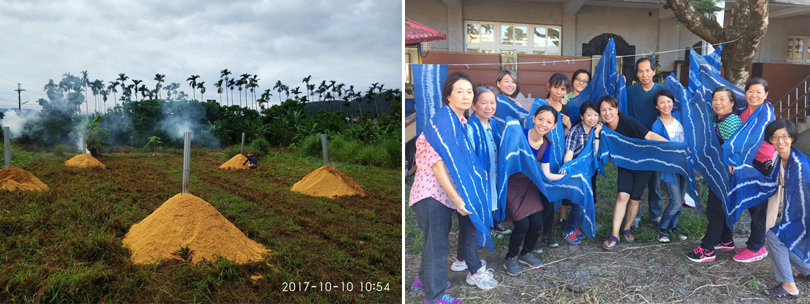
人本照護、里山內城
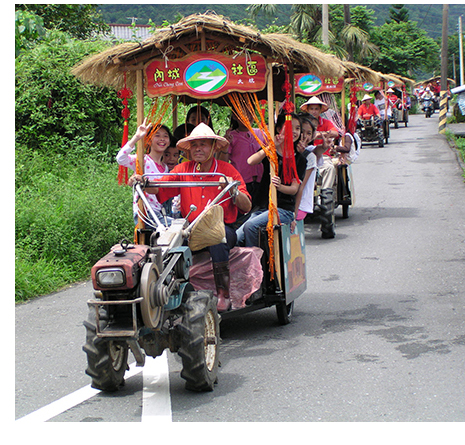 以人為本、以照護著手,過程中不斷引導、不斷創新,讓老人家經驗傳承、讓社區與空間改善、讓社區文化存續、讓社區居民保有受教育權,並加駐活躍老化及生產力老化思維,於民國2007年開始「鐵牛力阿卡車隊」的老人產業,並於民國2016年間開始發展周邊產業鏈,讓單一景點遊程發展出六條旅遊路線並強調深度旅遊極慢活旅遊的重要性。
目前鐵牛車計有38台,遊客數平均每個月約12,000人,創造長者第二春收入,帶動周邊商機發展,如老農假日市集、愛工坊二級產業、社區體驗遊程的鐵牛車文創商品,及近期成立的內城染生活美學創作工坊,增加婦女就業機會,目前社區以共創合作聘任的兩位婦女,對於家中生計不無小補。
以人為本、以照護著手,過程中不斷引導、不斷創新,讓老人家經驗傳承、讓社區與空間改善、讓社區文化存續、讓社區居民保有受教育權,並加駐活躍老化及生產力老化思維,於民國2007年開始「鐵牛力阿卡車隊」的老人產業,並於民國2016年間開始發展周邊產業鏈,讓單一景點遊程發展出六條旅遊路線並強調深度旅遊極慢活旅遊的重要性。
目前鐵牛車計有38台,遊客數平均每個月約12,000人,創造長者第二春收入,帶動周邊商機發展,如老農假日市集、愛工坊二級產業、社區體驗遊程的鐵牛車文創商品,及近期成立的內城染生活美學創作工坊,增加婦女就業機會,目前社區以共創合作聘任的兩位婦女,對於家中生計不無小補。
青年扶植、教育紮根
2017年成立第一座內城產業服務園區,讓二級產業得以在產地銷售並打造社區共同品牌,成為假日小農市集。我們提倡里山倡議,籌組安心農作共學社群,強化農作調查、土地調查及耕作方式調查,並將食農教育、循環經濟的應用列為主體發展,成立第一個CSA農場試辦計畫,應用家庭支持農業方式,減少食物里程碑,以達減塑減碳的目的,藉此也緊扣許多願意投身自然農法友善農作的年青人,讓他們的農作物能到園區販售。
2011年內城國小面臨裁撤命運時,我們攜手向宜蘭縣政府爭取國中小整併計畫,讓原榮源國中與內城國小合併成為宜蘭縣第一所公辦公營的實驗國中小,並在校方積極辦學推動下,發展雙軸併軌,建立食農教育基地、小公民社會教育等與社區息息相關的學習教育方向。基於社區與學校本為一家的互惠互助原則下,社區提供攤車給學校,讓學生作品得以推廣販售也能自給自足。
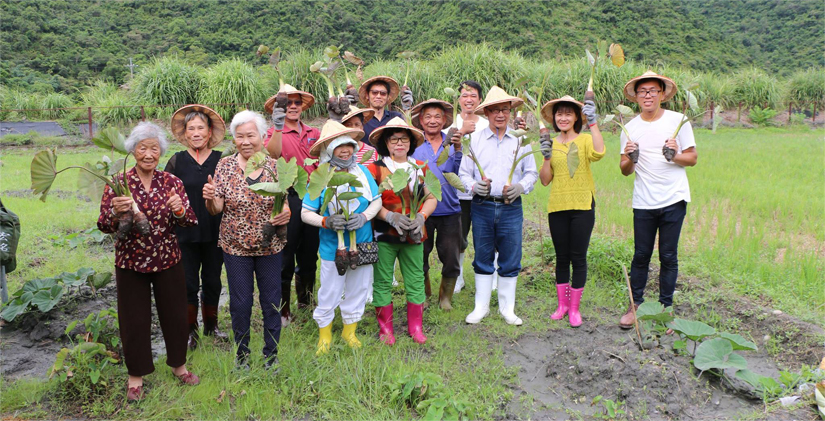
安老共好、組織永續
我們著重福利人口群的照顧,積極佈建社區照顧網絡,從個人、居家、社區到醫院,成立社區長青食堂提供長輩熱騰騰的午餐,也成立社區照顧關懷據點,於2016年與員山榮民醫院合作辦理照顧服務員培訓,並做足長照2.0執行人力準備,於2017年結合中央政府長照2.0計畫,將社區照顧關懷據點升級為加值型據點,提供週一到週五,十個時段的多元學習課程,與員山榮民醫院合作,除辦理延緩失能失智課程之外,還運用科技產物發展遠距健康管理系統,強化民眾健康管理的重要。2017年著手身心障礙的照顧,與員榮愛工坊合作,提供產業服務園區為販售愛工坊產品的基地,就近照顧弱勢族群提供弱勢族群社會參與機會,去機構化照顧平台,擁有自立生活的機會。
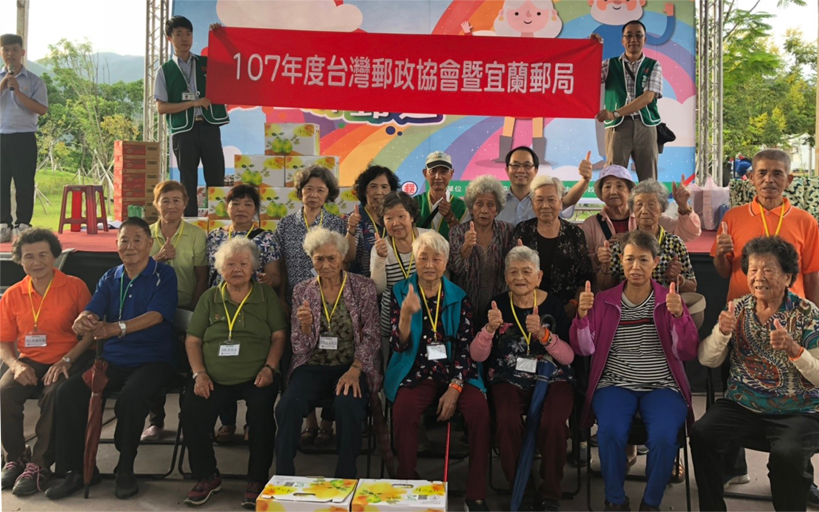
Satoyama Neicheng
If you mention “Neicheng Community” most people will ask, where is that? Anything fun to do or see there? Any good food? But if you bring up the A-ka “Iron Cows”, a look of recognition will come over their faces. These cleverly named “iron cows” are actually farming vehicles refitted to transport passengers through the community's beautiful natural landscapes.
The ins and outs of Neicheng Community's community development process are difficult to describe in a few simple words. Instead, let's go back in time to get a better view of how things played out.
Neicheng's Diverse Culture
 Called Neihuzai during the Japanese Occupation, the village is located in central Yuanshan Township in Yilan County with Yixian and Hubei Villages to the north, Shangde Village to the east, Zhenxiang Village to the south and Zhonghua Village to the west. It sits on 4.28 square kilometers, one third of which are located on the hills of the surrounding mountains. There are several ponds in the community including Taiyang, Qiangzailian, Jiadong, and Xunguan Ponds that retain their natural beauty.
Called Neihuzai during the Japanese Occupation, the village is located in central Yuanshan Township in Yilan County with Yixian and Hubei Villages to the north, Shangde Village to the east, Zhenxiang Village to the south and Zhonghua Village to the west. It sits on 4.28 square kilometers, one third of which are located on the hills of the surrounding mountains. There are several ponds in the community including Taiyang, Qiangzailian, Jiadong, and Xunguan Ponds that retain their natural beauty.
The main routes up Taipingshan and Lishan mountains run through the village. Relics of old military facilities are still visible on the mountain pass. Following an influx of immigrants from mainland China, every Chinese province was represented in the population. Added to the traditional Minnan society that already existed in the area, the community’s many groups created a rich and diverse culture. Shops on street corners included traditional steamed rice cakes, mainland Chinese-style beef noodle soup, and shaobing flatbread. In the present day, the population is aging and the community faces the task of taking care of older residents while many of them are parenting their grandchildren. Neicheng Community’s economy primarily relies on rice farming. This year, the community began promoting environmental protections and reductions in conventional farming practices. In addition to rice, water calla and tomatoes are also grown, and eco-farming practices help to attract young people to return to work the land, bringing diverse voices to add to the community’s vibrant culture.

People-centered care in Neicheng
 In Neicheng, we practice people-centered community building where care for others serves as our starting point. The process has included continuous guidance and continuous innovation. Through the process of community building, elders pass along their valuable experiences and we physically improve the community and our shared spaces, while preserving community heritage and ensuring residents’ right to education. Seniors are also encouraged to remain active and productive into old age. In 2007, the A-ka "iron cow" fleet was started to give older residents job opportunities and in 2016 other peripheral industries were created to support the fleet. From one single tour, we expanded to six different routes. Tours emphasize the importance of slowing down and getting an in depth understanding of the area.
In Neicheng, we practice people-centered community building where care for others serves as our starting point. The process has included continuous guidance and continuous innovation. Through the process of community building, elders pass along their valuable experiences and we physically improve the community and our shared spaces, while preserving community heritage and ensuring residents’ right to education. Seniors are also encouraged to remain active and productive into old age. In 2007, the A-ka "iron cow" fleet was started to give older residents job opportunities and in 2016 other peripheral industries were created to support the fleet. From one single tour, we expanded to six different routes. Tours emphasize the importance of slowing down and getting an in depth understanding of the area.
Currently, there are 38 "iron cow" vehicles, which transport an average of 12,000 riders a month and help provide income to elderly residents on their second career. New businesses catering to these visitors have sprung up, including a weekend senior farmers market, Love Workshop, "iron cow" souvenirs, and the recently-established Neicheng Fabric Dyeing Workshop that provides job opportunity to women in the community. As of today, the community has hired two women, enabling them to earn additional income for their families.
Support and education for young people take root
In 2017, the first Neicheng Industry Service Park was set up in order to ensure that products manufactured here could be sold locally to create a community brand. Eventually, this idea became the weekend farmers market. We advocate for the principles of the Satoyama Initiative and have set up a safe farming cooperative learning group and strengthened surveys of local agriculture, land and farming practices. Implementing food agriculture education and developing a circular economy are our primary focuses. We established a CSA farm trial project, where households can support local agriculture to cut down food waste and minimize carbon emissions and plastic use. Many young people interested in taking up natural farming can return to the community and sell their crops at the market.
When Neicheng Elementary School faced closure in 2011, we joined hands to negotiate with the Yilan County Government for the elementary to be combined with the local Rongyuan Middle School as the first publicly-operated experimental elementary and middle school in Yilan County. Under the active management of school officials, the school has developed dual-axis integration and established a food agriculture education center and little citizen social studies education to link young peoples’ education directly to the community. The community and school have a relationship based in reciprocity and mutual assistance. A stall in the local market was set aside for the school, where it can sell student crafts and become more self-reliant.

Caring for others is good for everyone
We focus on care for those populations receiving government assistance and have actively constructed a community care network that includes individuals, households, the community and even hospitals. We set up a community meal hall to provide hot lunches to elderly residents and established a Community Care Station. In 2016, in collaboration with Taipei Veterans General Hospital Yuanshan Branch, we held caregiver training sessions and readied staff to implement Long-Term Care 2.0. In 2017, in coordination with the central government's Long-Term Care 2.0 project, we upgraded the Community Care Station and now provide a variety of classes during 10 sessions daily from Monday through Friday. Working further with Taipei Veterans General Hospital Yuanshan Branch, the community not only held classes to slow the progression of dementia and physical disability, we also developed a long-distance health management system. In 2017, we expanded care to the disabled. Space is provided within the Neicheng Industry Service Park to sell goods produced by the Love Workshop, which provides local disadvantaged groups a chance for social participation. Through a deinstitutionalized care platform, these groups have the opportunity to live independently.


Copyright© 蘭陽博物館版權所有
